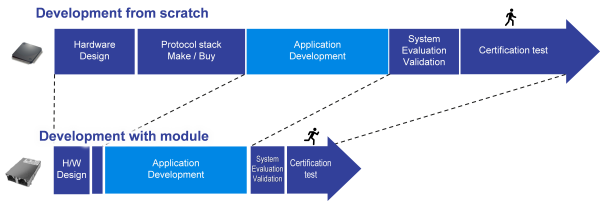Renesas' R-IN32M3 module is ready for EtherCAT®. With the hardware intact, simply updating the firmware will be able to support three major protocols: EtherCAT, on top of the existing PROFINET® and EtherNet/IP™. This blog introduces the development of EtherCAT-compatible products using this R-IN32M3 module.
What is EtherCAT?
EtherCAT is an open field network developed by Beckhoff Automation in Germany, managed and operated by the EtherCAT Technology Group (ETG). The physical packet format of EtherCAT is the same as the Ethernet frame specified in IEEE 802.3, but it has the original data format in the frame. The biggest feature is the high-speed, high-efficiency communication with "On-the-Fly" method. Packet data sent from the master device is transmitted sequentially to each slave device connected by an Ethernet cable and then folded back to the master (Figure 1). During this cycle, each slave reads and writes the data directly to the appropriate part of the packet data. To achieve this unique communication method, EtherCAT slave equipment requires dedicated hardware, but R-IN32M3 module can easily realize EtherCAT slaves with R-IN32M3-EC with integrated EtherCAT Slave Controller (ESC) and a dedicated protocol stack.

Figure 1. EtherCAT Communication
What is the R-IN32M3 module?
Renesas has released a variety of industrial Ethernet-compatible LSIs, but sometimes we hear the customer's voices that the development period and cost do not match for small-lot projects to be made from LSI. R-IN32M3 module is a product that responds to such voices. By connecting the host MCU via SPI communication, industrial Ethernet devices can be developed shortly.
Notable Features
- All-in-one and compact hardware
- Built-in three major industrial network protocols
- Efficient development environment

Figure 2. R-IN32M3 module
With the addition of EtherCAT support on top of the existing EtherNet/IP and PROFINET, the R-IN32M3 module can support close to 75% of the industrial Ethernet market needs with these three protocols. By updating to the latest firmware downloaded from the Renesas website, it can support EtherCAT without changing the hardware.
Development of EtherCAT-compatible products in 2 months!?
In the case of EtherCAT, much of the protocol processing is done by dedicated hardware, so communication operation can be achieved in a relatively short period of time, but it still takes about six months to a year to pass certification testing. R-IN32M3 module can also be shortened to about 2-6 months.
Figure 3 shows a rough image of the cost (duration or expense) of developing common industrial Ethernet equipment and then one using R-IN32M3 modules.
Figure 3. Development procedure
Let's take a look at each development step below.
Hardware Design
First of all, it is board development. R-IN32M3 module includes all required parts for EtherCAT, such as the two-port RJ-45 connectors with the peripheral circuitry, EtherCAT Slave Controller (ESC), and EEPROM necessary for EtherCAT. The board only needs to connect a 9-pin header for serial communication (SPI) with a host MCU and add the LED and ID selection switch circuitry for EtherCAT. The module is designed considering the Ethernet compliance testing and various reliability tests, which can significantly reduce development costs. (For more information, see User's Manual Hardware.)
Figure 4. Block Diagram
Implementation of Protocol Stack
One of the biggest features is that all protocol stacks are included in the module's firmware, which brings a notable cost benefit since there is no need to purchase them from protocol vendors. In addition, the firmware of the R-IN32M3 module will be updated free of charge with the protocol standard update approximately once a year. It is also a big advantage to be able to reduce TCO (total cost of ownership), including maintenance costs due to protocol updates.
Application Development
For host MCU firmware development, port the sample software provided by Renesas according to the hardware specifications. Figure 5 shows the overall flow of sample software for the host MCU, which has a simple software structure to implement a user's application in appl_loop().

Figure 5. Flow of Sample Software
Protocol Certification
To launch not only EtherCAT but also products compatible with each industrial Ethernet protocol, your product must be certified by the Protocol Association. This requires a certain amount of know-how, but it is helpful that the R-IN32M3 module has already obtained ETG certification in a configuration that combines the R-IN32M3-Module-Solution-Kit and the SK-S7G2 Starter Kit. By checking in advance using the Conformance Test Tool (CTT) provided by ETG, it would be passed without any problems.
Conclusion
Development of EtherCAT slave devices using the R-IN32M3 module was described. It is also a big feature of the R-IN32M3 module that it supports multiple protocols including PROFINET and EtherNet/IP. In other words, it is possible to create a product that corresponds to multiple protocols without changing the hardware at all. Please visit Renesas website by all means.


